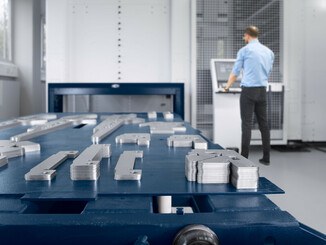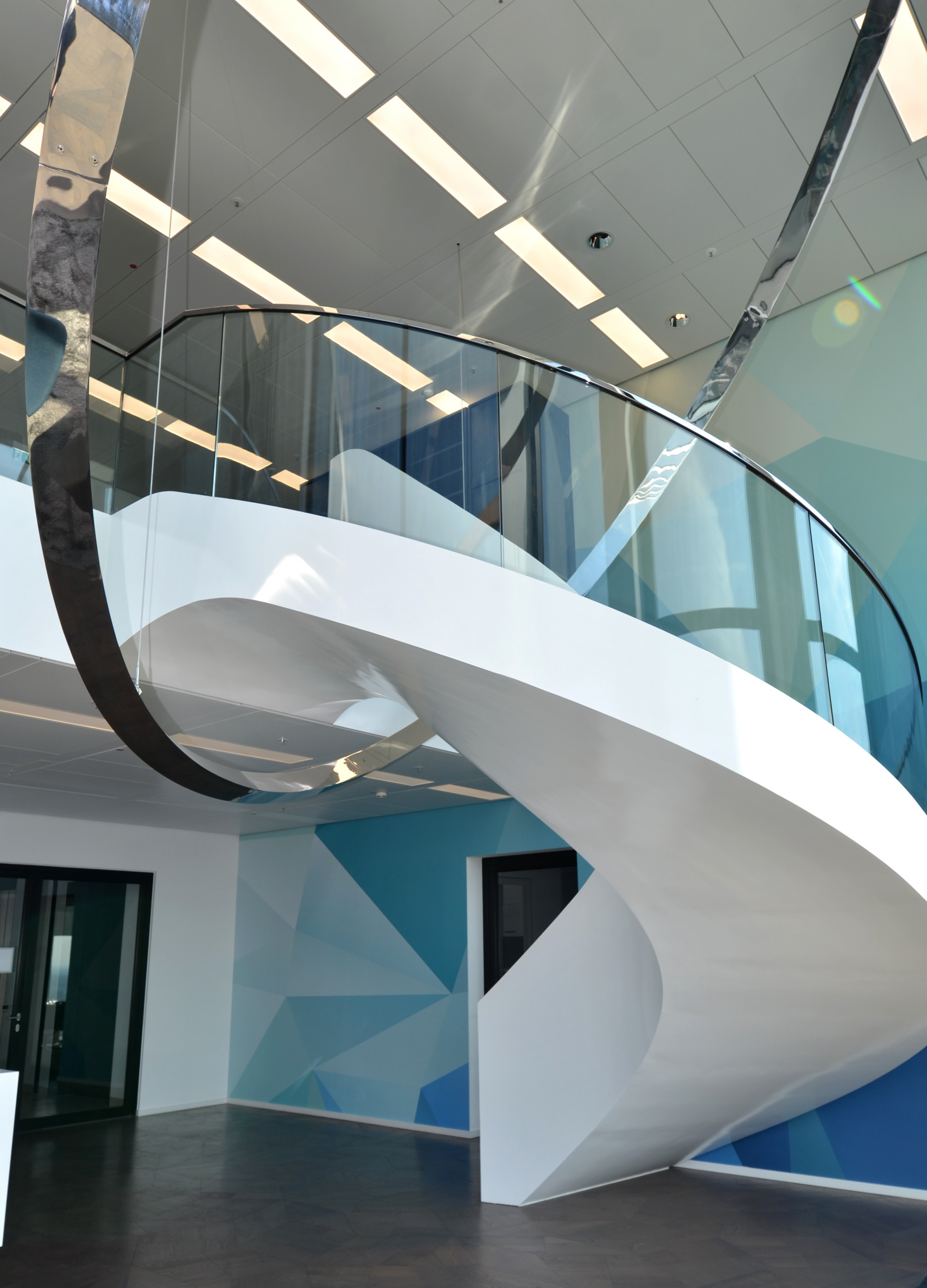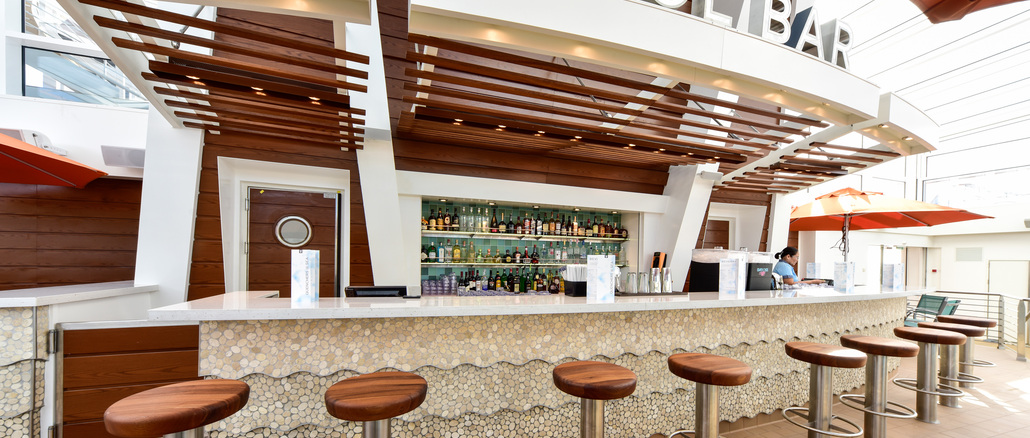
Exposed sheets and metal10 substructures from Stiegeler Metallbau can be found in cruise ships as well as in billionaire yachts. The high quality, delivery reliability and speed required for this are achieved by the medium-sized company through know-how and high-quality machinery, which includes several Trumpf machines and the TruTool TSC 100 special tool. The latter is used to remove slag from pallet tables of the TruLaser 3040 fiber – this is economical and sustainable.
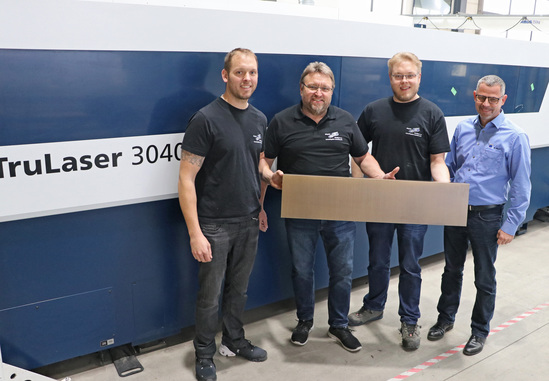
© Trumpf
When Georg Stiegeler became self-employed in 1985 as a newly qualified master locksmith in the Bavarian-Swabian town of Ettringen (Unterallgäu), he primarily had his craft in mind: “I wanted to realize myself as a master locksmith and had my parents-in-law’s former cowshed at my disposal for this purpose. I succeeded quite well with a few private customers. However, over the years I realized that my line of work was changing. Other work was desired and I had to adjust my processes accordingly.”
Orders from local authorities and hotels in particular reinforced this trend, so that Georg Stiegeler purchased his first analog milling machine at the beginning of the 1990s. When his eldest son Christian discovered his love of metal a few years later, the new direction accelerated. Just 17 years old, he surprised his father by buying his first used CNC milling machine at an auction as an apprentice. This was the starting signal for the path to a successful medium-sized metal construction company in 2000, and Christian Stiegeler played a major role in shaping it. In the meantime, a three-axis and a five-axis milling machine as well as two CNC automatic lathes with driven tools stand for highest precision in mechanical production.
By laser in the direction of metal construction

© Trumpf
Since 2006, Christian Stiegeler has been managing the business together with his father as a master craftsman and business economist. They invested in a 3D CAD system and are constantly expanding their machinery. The Stiegelers describe their investments in Trumpf technology as particularly important. “In 2012, we bought our first CO2 laser machine. At that time, we sought many opinions, compared several suppliers and ultimately decided on a used Trumpf,” reports the junior boss.
This significantly increased the company’s flexibility and productivity while reducing throughput times for mild steel and stainless steel workpieces. This was particularly important because orders from general contractors for the interior finishing of cruise ships, large yachts, hotels as well as luxury boutiques increased enormously. Important prerequisites for this: short delivery times and high component quality.
Among other things, clean pallet tables are important for the quality of laser machines. If too much slag has accumulated, it can splash back onto the sheet metal and visually damage the surface. Initially, Stiegeler employees tried to remove the slag mechanically – with a lot of force and little success. A friendly company had a better solution: the TruTool TSC 2, the first variant of a support strip cleaner from Trumpf.
The device could “only” remove normal construction steel slag, as Georg Stiegeler recounts: “At the time, it was nevertheless helpful, because we worked a lot with this material and thus had to replace the pallet tables less frequently.”
Innovative machines and tools
In the meantime, Stiegeler is several steps ahead in several respects. The family business owns two innovative bending machines from Trumpf, the TruBend 5085 and TruBend 5320, which are extremely easy to program, set up and operate, according to the managing directors. Since 2018, the TruLaser 3040 fiber, a state-of-the-art solid-state laser system including a new TruTool TSC 100 support bar cleaner, has also been in the factory hall.
According to Christian Stiegeler, the new laser machine in particular “was a big investment for us as a small medium-sized company. But it’s worth it, and we’re taking another big step in our range of services with it.” The TruLaser fiber is particularly important because of the enormous increase in requests for components made of brass, copper and aluminum. These materials are experiencing a real renaissance in large yachts, cruise ships and hotels.
Georg Stiegeler is pleased about this, because “as a metalworker, working with non-ferrous metals is in my blood anyway. We know exactly what needs to be taken into account when processing these materials – in welding and soldering as well as in edging, bending or cutting. That’s paying off again now.”
Lead time for non-ferrous metal parts: from three days to ten minutes
Christian Stiegeler is also pleased with this development and explains why the new TruLaser fiber with its solid-state laser is so important in this context: “Non-ferrous metals cannot be cut with the CO2 laser because the reflection of the laser light can be very dangerous for the machine and for bystanders.”
However, outsourcing such work not only costs money, it also takes a lot of time: “We used to have non-ferrous metals cut by a neighboring company using a water jet system. That took at least two, usually three or more days. With the TruLaser 3040 fiber, we need no more than ten minutes for such individual pieces. It’s extremely fast, easy to operate, and we always decide for ourselves what goes on the machine and when.”
Primarily, Stiegeler processes thin visible elements for interior cladding and the like with a material thickness of one to six millimeters. The substructure also requires support frames, fasteners et cetera, which can be significantly thicker. The TruLaser 3040 fiber easily cuts 25 millimeter thick steel, stainless steel and aluminum. Brass and copper are possible up to 10 millimeters.
Thanks to the large traverse paths in the X and Y directions of 2 x 4 meters, long components such as stairs can also often be prepared in one piece. At the same time, the solid-state laser machine is enormously sustainable and productive. Compared to the previous CO2 system, the TruLaser 3040 fiber consumes 40,000 kWh less energy per year and requires no laser gas. However, it is around five times faster when cutting.
The setup is also much easier and takes much less time. Whereas with CO2 lasers the appropriate cutting head must always be used and laboriously adjusted, depending on the material type and thickness, such work is completely unnecessary with solid-state lasers, since they are equipped with an automatic nozzle changer.
Clean support strips instead of disposing of them
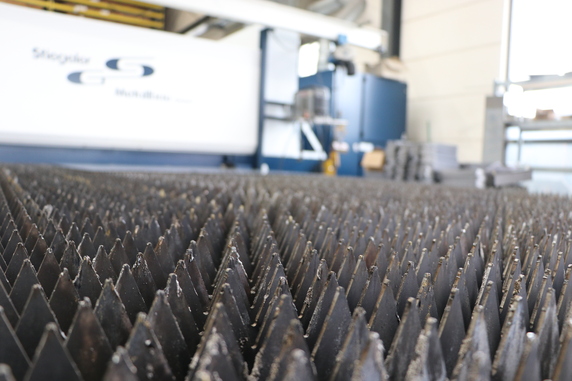
© Trumpf
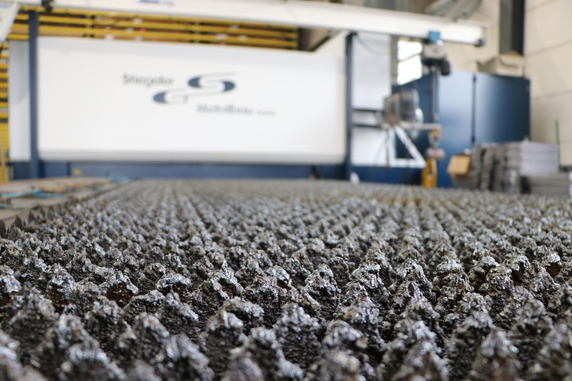
© Trumpf
However, slag continues to form on the pallets. “It can never be avoided,” emphasizes Georg Stiegeler’s youngest son Benjamin. He has also been working for the company since 2013 as a master craftsman and business economist and is responsible for laser processing. He adds, “Removing the slag is not much of a problem today because we use the modern TruTool TSC 100 support bar cleaner.”
Whereas in the first TruTool TSC 1 and TSC 2 models, powerful rollers crumbled the slag, in the current model two toothed cleaning tools clamp the bar, travel up it vertically and in this way thoroughly scrape off the slag, both laterally and between the tips.
Trumpf technical consultant Markus Wirth explains the most important difference from the previous model: “The device removes all materials that the laser can cut. So also stubborn stainless steel slag, brass, copper, aluminum and so on.” In addition, the TruTool TSC 100 can be easily operated by one employee. He puts the machine on, turns it on, runs the bar and puts it in the next row, until the entire pallet is cleaned. “We need about two hours each for our two large four-by-two meter tables. Since we work a single shift on five to six days and mainly cut thin sheets up to six millimeters, this is usually only necessary once a month. We then only have to replace the pallets about every year and a half.”
Amortization on first use
The savings from the Trumpf tool amount to a good five-digit euro amount per year for the material alone. Because at current steel prices, the two tables cost more than 3,000 euros per replacement. In addition, some valuable machine and employee time can be put to better use. After all, it takes about five times as long to make the support strips and replace them as it does to clean them. “From this point of view, the TruTool TSC 100 from Trumpf has already paid for itself after the first use for our two pallet tables, the Stiegelers agree: “We also like the fact that we can work sustainably in this way and use significantly less valuable steel.”
Web:
www.trumpf.com


